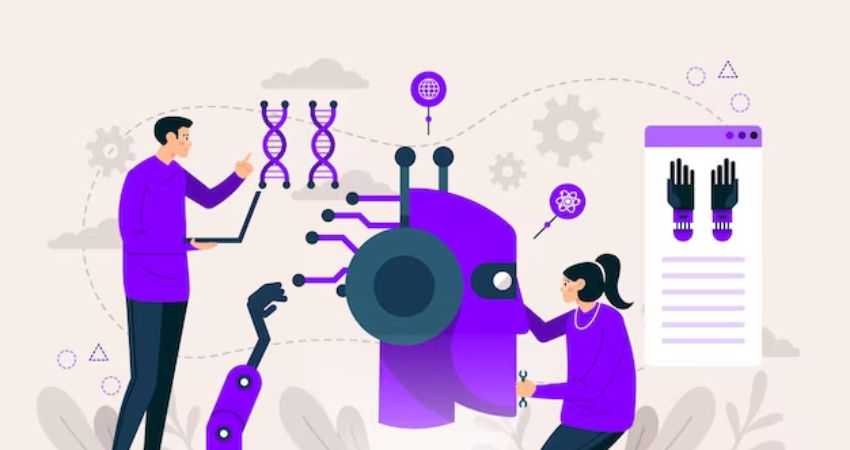Artificial Intelligence (AI) refers to developing computer systems or software that can perform tasks that typically require human intelligence, such as visual perception, speech recognition, decision-making, and language translation. Machine Learning (ML), a subset of AI, is a technique for realizing AI by training algorithms to recognize patterns in large datasets and then use those patterns to predict future outcomes or behaviors. ML models are built using statistical methods, allowing them to improve their performance over time as they process more data.In this blog,I tell you about the Examples of AI and Machine learning.
Difference between AI and Machine Learning
Although both Artificial Intelligence (AI) and Machine Learning (ML) share similarities and often overlap, there are some key differences between the two:
- Scope:
AI encompasses a broader range of concepts related to creating intelligent agents capable of mimicking or surpassing human intelligence across various domains. In contrast, ML focuses specifically on developing algorithms that enable computers to learn from data and make predictions or take actions based on that learned information. - Methodology:
AI involves designing rule-based systems, heuristics, symbolic logic, and other computational methods to achieve desired intelligent behavior. On the other hand, ML relies primarily on statistical analysis and optimization techniques to extract insights from data, which drives its ability to make informed decisions or predictions. - Goal:
The primary aim of AI is to build general-purpose intelligent systems that can solve complex problems, reason abstractly, understand context, and transfer knowledge across different domains. Meanwhile, ML targets domain-specific applications where abundant data is available, focusing on improving prediction accuracy and model robustness rather than achieving broad cognitive abilities. - Data dependency:
AI systems may not necessarily rely on vast amounts of data; instead, they could be designed using expert knowledge, rules, or logical reasoning. However, ML models heavily depend on data availability since they leverage patterns within data to drive their decision-making processes. - Adaptability:
AI systems can potentially exhibit greater flexibility in adapting to novel situations or environments due to their design principles, incorporating explicit rules, symbolic representations, or higher-level abstractions. Conversely, ML models might struggle when encountering out-of-distribution samples because they mainly focus on optimizing existing patterns and cannot reason beyond their learned boundaries. - Human intervention:
Some AI systems can operate independently once deployed, requiring minimal human oversight. For example, expert systems or planning algorithms don’t need continuous monitoring. Nevertheless, most ML models demand regular updates, fine-tuning, or hyperparameter adjustments to maintain peak performance, necessitating ongoing human involvement.
In summary, while AI aims to develop intelligent systems covering diverse aspects of cognition, ML concentrates on enabling these systems to learn from data efficiently, leading to improved decision-making capabilities. Both areas complement each other but have distinct objectives, methodologies, and scopes.
Examples of AI and Machine Learning

Examples of AI and Machine learning are given below:
1. Virtual Personal Assistants
Virtual personal assistants like Siri, Google Assistant, and Alexa are prime examples of AI in action. These intelligent agents leverage natural language processing (NLP) algorithms to understand and respond to user commands. By continuously learning from user interactions, they adapt to individual preferences, providing personalized assistance, weather updates, appointment scheduling, and much more. Their ability to comprehend context and deliver relevant information showcases the power of AI in enhancing user experiences and simplifying daily tasks.
2. Image Recognition
AI-driven image recognition has transformed various industries, from security to healthcare. Advanced algorithms analyze visual data, enabling facial recognition, object detection, and image categorization. In healthcare, for instance, this technology aids in medical imaging interpretation, helping diagnose conditions accurately. Security systems use image recognition for surveillance, identifying potential threats or unauthorized individuals. The versatility of image recognition highlights its significance in making processes more efficient and secure.
3. Speech Recognition
Speech recognition systems, powered by AI, have revolutionized how we interact with technology. These systems employ machine learning algorithms to convert spoken language into text, enabling voice-controlled devices and transcription services. Beyond virtual assistants, applications include voice-operated software, voice search, and accessibility features for those with disabilities. Continuous advancements in speech recognition technology contribute to the development of more natural and intuitive human-computer interfaces.
4. Chatbots
AI-driven chatbots have become integral to modern customer service strategies. These automated conversational agents simulate human interactions, addressing inquiries, providing information, and assisting users in real time. By leveraging natural language understanding and machine learning, chatbots offer efficient and personalized responses. They operate 24/7, improving customer engagement and satisfaction. Businesses across various sectors, from e-commerce to healthcare, utilize chatbots to enhance user experiences and streamline communication.
5. Recommendation Systems
Recommendation systems powered by AI have transformed how we discover content and products online. Platforms like Netflix, Amazon, and Spotify analyze user behavior using machine learning algorithms to suggest personalized content. These systems consider factors such as viewing history, preferences, and trends to make accurate and engaging recommendations. The success of recommendation systems underscores the importance of AI in delivering tailored experiences and influencing user engagement and decision-making.
6. Autonomous Vehicles
The development of autonomous vehicles represents a groundbreaking application of AI in the transportation sector. Self-driving cars utilize a combination of sensors, machine learning algorithms, and advanced computing to navigate, interpret traffic conditions, and make real-time decisions. AI ensures these vehicles can adapt to unpredictable scenarios, enhancing safety and efficiency. With ongoing advancements, autonomous vehicles have the potential to revolutionize the future of transportation and reduce accidents caused by human error.
7. Predictive Analytics
AI-driven predictive analytics is a powerful tool for businesses seeking insights into future trends and behaviors. By analyzing historical data and identifying patterns, machine learning algorithms predict outcomes and trends, aiding decision-making processes. Industries ranging from finance to marketing leverage predictive analytics for risk management, demand forecasting, and personalized marketing strategies. The ability to anticipate future scenarios provides a competitive edge and enhances strategic planning.
8. Healthcare Diagnostics
AI plays a crucial role in healthcare diagnostics, particularly in medical imaging. Machine learning algorithms analyze images from various medical scans, such as X-rays and MRIs, assisting in the detection and diagnosis of diseases. These AI applications contribute to early intervention, personalized treatment plans, and improved patient outcomes. As technology advances, the integration of AI in healthcare continues to revolutionize diagnostics and enhance the accuracy of medical assessments.
9. Fraud Detection
In the financial sector, AI is a key player in fraud detection and prevention. Machine learning algorithms analyze vast datasets, identifying patterns and anomalies that may indicate fraudulent activities. Whether in credit card transactions, online banking, or insurance claims, AI-powered fraud detection systems provide real-time alerts, mitigating financial risks and securing transactions. The adaptive nature of AI ensures continuous improvement in identifying new and sophisticated forms of fraud.
10. Language Translation
AI-driven language translation services break down language barriers, facilitating communication on a global scale. Machine learning models analyze linguistic nuances and context, providing accurate and contextually relevant translations. From online content translation to language interpretation apps, AI has made significant strides in enabling cross-cultural communication. The continuous refinement of language translation technology showcases the adaptability and versatility of AI applications
11. Robotics
Robotics powered by AI has ushered in a new era of automation. AI-driven robots are capable of performing complex tasks in various industries, from manufacturing to healthcare. These robots use machine learning algorithms to adapt to changing environments, improving precision and efficiency. In manufacturing, for example, robotic arms equipped with AI can enhance production lines by assembling products with high accuracy. The integration of AI in robotics showcases the potential for intelligent automation in diverse fields.
12. Gaming
AI’s impact on the gaming industry is evident in the development of intelligent non-player characters (NPCs) and dynamic game environments. Machine learning algorithms allow NPCs to learn from player interactions, adjusting behaviors and difficulty levels in real time. This adaptive gaming experience enhances player engagement, providing a personalized and challenging journey. AI’s role in gaming extends to procedural content generation, creating diverse and immersive game worlds based on player preferences.
13. Virtual Reality (VR) and Augmented Reality (AR)
AI contributes significantly to immersive experiences in VR and AR applications. Machine learning algorithms enhance these technologies by creating realistic simulations and intelligent overlays. In VR, AI enables natural interaction within virtual environments, while AR applications use computer vision to seamlessly integrate digital information into the real world. From virtual training simulations to interactive educational experiences, AI enhances the capabilities of VR and AR, creating more immersive and engaging content.
14. Cybersecurity
AI is a vital component in modern cybersecurity strategies. Machine learning algorithms analyze network behavior, detect anomalies, and identify potential threats in real time. AI-driven cybersecurity systems continuously adapt to evolving cyber threats, providing proactive defense measures. Whether it’s detecting malware, preventing phishing attacks, or securing sensitive data, the integration of AI in cybersecurity strengthens digital defenses and minimizes vulnerabilities.
15. Natural Language Processing (NLP)

Natural Language Processing (NLP) is a subset of AI that focuses on the interaction between computers and human language. NLP enables machines to understand, interpret, and generate human-like language, powering applications like chatbots, language translation, and sentiment analysis. Advances in NLP have led to more accurate language models, facilitating improved communication and comprehension between machines and humans.
16. Financial Trading
AI algorithms play a pivotal role in financial trading by analyzing vast datasets and predicting market trends. Automated trading systems utilize machine learning to execute buy or sell orders based on predefined criteria, responding swiftly to market changes. The speed and accuracy of AI-driven trading contribute to more efficient and informed investment strategies, impacting financial markets globally.
17. Social Media Content Moderation
AI is employed in social media platforms for content moderation, sifting through vast amounts of user-generated content to identify and filter out inappropriate or harmful material. Machine learning algorithms can recognize and categorize content based on predefined criteria, assisting in maintaining a safe and positive online environment.
18. Weather Prediction
Machine learning models enhance weather prediction by analyzing historical and real-time data. AI algorithms can identify complex patterns and correlations in meteorological data, improving the accuracy of weather forecasts. This has significant implications for disaster preparedness, agriculture planning, and various industries dependent on weather conditions.
19. Recommendation Systems in E-commerce
E-commerce platforms leverage AI-powered recommendation systems to enhance user experience and drive sales. By analyzing user behavior, preferences, and purchase history, machine learning algorithms generate personalized product recommendations. This not only increases customer engagement but also improves conversion rates, showcasing the impact of AI in shaping online shopping experiences.
20. Energy Management
AI is instrumental in optimizing energy consumption and grid management. Machine learning algorithms analyze data from energy systems to predict demand, optimize distribution, and enhance overall energy efficiency. Smart grids and AI-driven energy management contribute to a more sustainable and resilient energy infrastructure.
21. Sentiment Analysis
Sentiment analysis, powered by AI, evaluates and understands the sentiment behind text data, such as social media posts or customer reviews. Machine learning algorithms can determine whether the expressed sentiment is positive, negative, or neutral. Businesses use sentiment analysis to gauge public opinion, customer satisfaction, and brand perception, informing decision-making and marketing strategies.
22. Personalized Learning
AI is making significant contributions to education through personalized learning experiences. Machine learning algorithms analyze students’ learning patterns, adapting content and pacing to individual needs. This tailored approach enhances student engagement, comprehension, and overall academic performance.
23. Human Resource Management
AI assists in various aspects of human resource management, from recruitment to employee engagement. Machine learning algorithms streamline the hiring process by analyzing resumes, identifying suitable candidates, and even predicting employee turnover. AI-driven tools contribute to creating more efficient and data-driven HR strategies.
24. Agricultural Automation
AI-driven technologies are transforming agriculture by automating tasks such as planting, harvesting, and crop monitoring. Machine learning algorithms analyze data from sensors and drones, optimizing crop yield, resource utilization, and overall farm management. This contributes to sustainable and precision farming practices.
25. Medical Research and Drug Discovery
AI accelerates medical research and drug discovery by analyzing vast datasets related to genetics, diseases, and drug interactions. Machine learning algorithms can identify potential drug candidates, predict treatment responses, and optimize research processes. This integration of AI in healthcare research holds promise for advancing medical breakthroughs.
26. Supply Chain Optimization
AI enhances supply chain management by optimizing inventory, predicting demand, and improving overall efficiency. Machine learning algorithms analyze data from various sources, enabling businesses to make informed decisions, reduce costs, and enhance the resilience of their supply chains.
27. Emotion Recognition
AI can recognize human emotions through facial expressions, voice tone, and other cues. Emotion recognition technology has applications in human-computer interaction, virtual therapy, and market research. By understanding emotional states, AI systems can provide more empathetic and personalized experiences.
28. Autonomous Drones
Drones equipped with AI technology are used for various applications, including surveillance, delivery, and environmental monitoring. Machine learning algorithms enable drones to navigate autonomously, avoid obstacles, and perform tasks with precision. The integration of AI in drones expands their capabilities, making them valuable tools in diverse industries.
29. Personal Finance Management
AI-powered financial apps analyze users’ spending patterns, provide budgeting advice, and offer personalized financial recommendations. Machine learning algorithms can predict financial trends, helping users make informed decisions about their investments, savings, and overall financial health.
30. Wildlife Conservation
AI contributes to wildlife conservation efforts by analyzing data from camera traps and satellite imagery. Machine learning algorithms can identify and monitor endangered species, track animal movements, and assess the health of ecosystems. This technology aids conservationists in making data-driven decisions to protect biodiversity.

